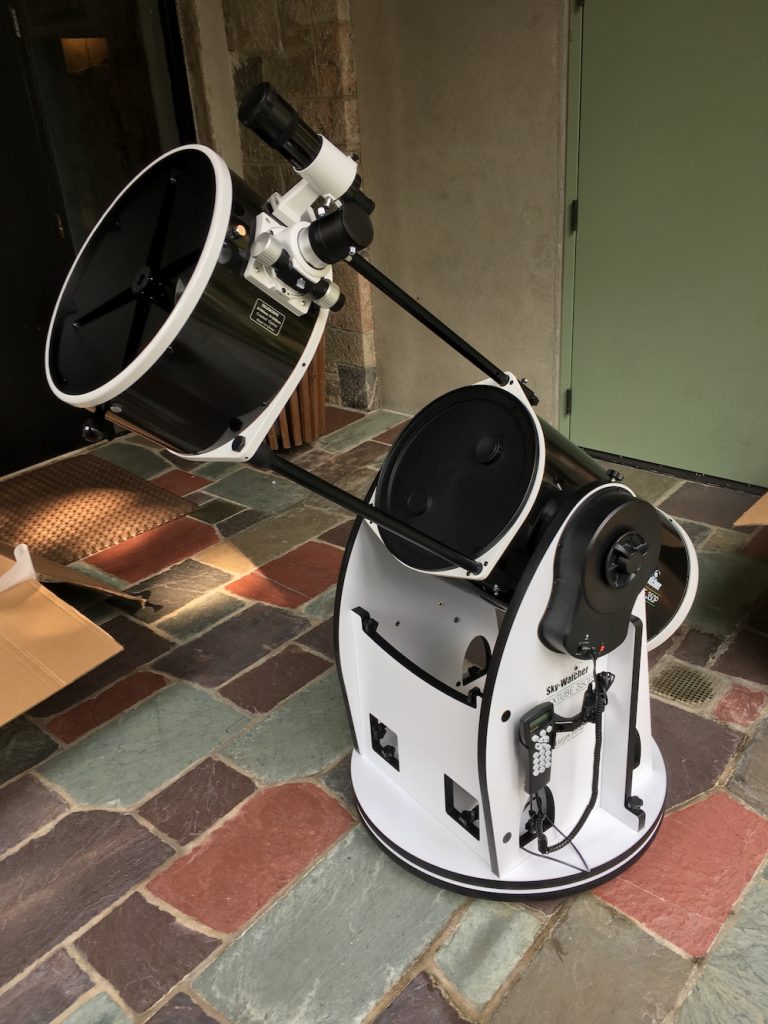The Optical Tube

The Skywatcher Skyliner 350P FlexTube GoTo Dobsonian is a 14” (356mm) f/4.6 Newtonian reflector with a focal The Sky-Watcher’s 14” or 350P FlexTube GoTo Dobsonian is a 14” (356mm) aperture Newtonian reflector with a focal length of 1650mm and focal ratio of f/4.6. At the fast focal ratio of f/4.6, coma is evident when I use any of my wide-angle 2” eyepieces, and if I’m using cheaper ones, my views get wrecked by additional aberrations like edge-of-field astigmatism.
For the same reasons, budget options such as 2” wide-angle “SuperView” and “SWA” type eyepieces are going to be a bit of a mess on such a fast instrument. You will ideally want to use well-corrected UWA/Nagler or XWA/Ethos type eyepieces, as well as possibly a coma corrector, for sharp low-power views.
Likewise, collimation is fairly critical; a good laser collimator or Cheshire will be necessary. I have to re-collimate the primary mirror of the 14” FlexTube every time the tube is extended or collapsed.
Collimation and Focusing
Collimation of the 14” FlexTube’s primary mirror is adjusted with standard hand knobs at the back of the optical tube, while the secondary mirror at the front is adjusted with a hex key. Since secondary mirror adjustment is so seldom needed, I believe installing thumb screws would be a waste of money and might even lead to a more frequent need for re-collimating the secondary.
Focusing is also fairly stringent at f/4.6, especially at the typically high magnifications I often find myself using with this scope, but thankfully the 350P FlexTube comes equipped with a nice dual-speed 2” Crayford focuser.
The 14” FlexTube’s trusses have a second setting to provide enough in-focus travel if I’m to use a binoviewer or camera. It nonetheless has plenty of back-focus as it requires me to use an focus extension tube to use with most eyepieces, of which two are provided (a 1.25” and a 2″), as is the typical nonsense with Sky-Watcher’s extension tubes.
The Primary Mirror Design
The 14” FlexTube, as with its 16” counterpart, features a conical, ribbed primary mirror made out of low-expansion borosilicate glass.
The conical primary mirror cuts down on weight as well as reduces the time it takes for the mirror to acclimate to ambient temperature. There are no fans provided by default, but you can and should attach at least one fan to the back of the primary mirror to aid in cooling.
The conical primary can cause some concern with “print through” of the ribs to the front optical surface, creating less-than-sharp images. But I mostly see this to be a problem with the larger 18” and 20” scopes, which Sky-Watcher has quietly stopped selling in most markets.
The Collapsible Tube Design
The 350P FlexTube GoTo, of course, features the FlexTube design of three struts, which collapse in a few seconds. This reduces the optical tube’s length from 60” to 38.5,” making it possible for me to fit the optical tube across the back of my car. It is only slightly longer than the 12” FlexTube model when collapsed.
However, at 53 lbs (24 kg), the 14″ FlexTube is heavier than even a solid-tubed 12” optical tube, and it’s still fairly awkward for me to carry around despite the presence of built-in handles.
For comparison, my entire 14.7” truss tube telescope that I custom built at home weighs 53 lbs (40 lbs being the tube), and being a true truss design, it disassembles into portions weighing no more than 25 lbs each. Truss tube scopes are a lot less awkward to handle as their individual pieces. So while the FlexTube may be simpler and free of as many knobs or easily missing parts, you pay dearly in physical diskomfort moving it around.
Attaching the Tube to the Base
In my experience, attaching the 14” FlexTube GoTo to its Dobsonian Base was fairly simple.
I rotate the left-side bearing holder horizontally to line up with a slot in the left bearing attached to the tube, lower the tube onto the base horizontally (aimed at the horizon), and tighten a single knob to secure the bearing in place. The right side altitude bearing just pivots freely on a pair of plastic cylinders, like a manual Dobsonian.
Accessories
The 14” FlexTube GoTo Dobsonian comes with typical 1.25” 25mm (providing 66x magnification) and 10mm (165x) “Super Plossl” oculars. These are nice enough eyepieces, and their well-corrected but narrow 50-degree apparent field of view means I don’t see a lot of issues with coma or astigmatism. But they are far from what you should probably be using with a scope of this size and cost.
The finder provided with the 14” FlexTube GoTo is a 9×50 straight-through finder scope that has crosshairs, a roughly 6-degree true field, and a view that’s flipped upside-down. It is really only provided for aligning the GoTo system of the scope and is rather uncomfortable to use compared to a right-angle finder or reflex sight. Interchanging it with a lighter-weight red dot/reflex sight or a right-angle, correct-image finder is easy, thanks to the standard Synta/Vixen-style finder shoe.
Mount
The 14” FlexTube GoTo Dobsonian uses the same design as all of the other Sky-Watcher GoTo Dobsonians.
At its core, being a Dobsonian, the 14” FlexTube GoTo is an alt-azimuth design, pivoting left-right and up-down, with a mount made out of wood. However, being motor-driven, I can, of course, spot a few changes.
The scope’s optical tube attaches to a servo-driver altitude axis motor on one side and pivots on simple plastic pads like a conventional Dobsonian on the other bearing. This reduces the torque needed for the altitude axis motor to move the scope and eliminates the need for a pair of them, as well as reducing setup time and weight.
The azimuth axis is a roller bearing driven by another massive servo motor.
Both the altitude and azimuth axis use slip clutches, allowing us to unlock them by turning knobs to point the whole scope manually. Dual encoders will tell the telescope where we have manually aimed it, allowing the motors to continue to find and track objects in the sky accurately even when we use it manually—a feature many cheap GoTo scopes that I’ve used lack. Sky-Watcher terms the slip clutch/dual encoder combination their “FreedomFind” technology, but I know of many other telescope brands that also have this ability.
Mainly due to the base’s additional height imposed by the azimuth motor housing, the height of the 14” FlexTube GoTo’s focuser/eyepiece when I aim the scope at the zenith is roughly 64” above the ground. This means that if you are less than six feet tall, you will need a step stool or short ladder to look through the eyepiece when the scope is pointed straight up, though for most of the sky, you can remain with your feet on the ground unless you are unusually short.
Both Hand Controller and WiFi Adaptor to Control
I also like that the 14” FlexTube GoTo comes with Sky-Watcher’s standard SynScan controller as well as a built-in WiFi adaptor by default; the smaller scopes have either as an option.
We have to pick between the hand controller or controlling the scope via our smartphone/tablet over WiFi when we power it on. For me, using a device over WiFi feels a little more intuitive, but I know that some people prefer the feedback and closed system of the hand controller.
Either one will require an alignment process, either a standard 2- or 3-star alignment or a less accurate “quick align,” which may be all I need if I just want motorised tracking while I putter around manually or simply want to enjoy viewing the Moon and planets.
The Mount’s Difficulties in Portability
The 14” FlexTube GoTo’s base dismantles for transport, and the front and side boards detach from the ground/azimuth board with hand knobs in a few minutes.
However, the massive ground board is about 54 lbs (24 kg) and 30” wide, with few points to grab—arguably worse to pick up and move than the optical tube itself, which weighs about the same amount. The most convenient way to move the ground board around is to simply roll it on its rubber-rimmed edge like a big tire, which can be a little diskoncerting but works well enough as long as you avoid damaging the base or kicking up rocks or debris into the middle of the motor housing.
Aftermarket Accessory Recommendations
It is absolutely essential to purchase a stiff fabric shroud for the SkyWatcher Skyliner 350P FlexTube GoTo Dobsonian’s open tube, as is the case with almost any open-tubed strut or truss telescope. Without a shroud, glare from the Moon, nearby sources of light such as street lamps or passing cars, and the general glow of light-polluted skies will significantly impact contrast at the eyepiece, severely affecting the views through this telescope, especially those of faint deep-sky objects like nebulae and galaxies where maximum contrast and darkness are required to see anything at all. A shroud also mitigates the formation of dew and frost on the telescope’s dew magnet of a secondary mirror and will tend to keep your optics cleaner too.
You’re also going to be sure to want to replace the 350P’s included 3-element eyepieces, though with such an expensive telescope there are a myriad of options. However, I can certainly provide a few recommendations. A 28mm UWA (60x) or another high-quality UWA or XWA eyepiece in the 20-30mm range such as the Explore Scientific 82-degree or 100-degree line makes for an ideal low-power eyepiece, especially if coupled with a suitable coma corrector such as the Explore Scientific HRCC. If you’re not using a coma corrector, I’d recommend replacing the 350P FlexTube’s included 2” extension tube with one that utilises a compression ring adapter, and you’ll likewise want to do the same for a replacement 2” to 1.25” adapter and obtain one with filter threads so 2” filters will fit your 1.25” eyepieces. A good cheshire collimation tool is also a must.
For higher magnifications, I would recommend at least another 2 or 3 eyepieces, such as a 16mm UWA (103x) and 7mm UWA (235x), for the 350P, along with something like a 4mm UWA or planetary eyepiece (413x) if your atmospheric conditions permit such high magnifications. Additional eyepieces besides these might also be a good idea.
Additionally, using a high-quality narrowband Ultra High Contrast (UHC)/OIII nebula filter can greatly improve your views of nebulae, such as the Orion Nebula, with almost any telescope, including the Skyliner 350P FlexTube GoTo Dobsonian. This filter also enhances the visibility of planetary nebulae by dimming the brightness of nearby stars, making it more straightforward to locate them at low power. Furthermore, it offers sufficient contrast enhancement to uncover previously unseen nebulae, like the Crab Nebula, Crescent Nebula, Veil Nebula, or Flame Nebula, when using the Skyliner 350P FlexTube GoTo Dobsonian under dark skies. A 2″ nebula filter can be connected to an aftermarket threaded 1.25″ adapter, as mentioned earlier, ensuring compatibility with either size eyepiece.
Should I buy a Used Skywatcher Skyliner 350P FlexTube GoTo Dobsonian?
The SkyWatcher Skyliner 350P FlexTube GoTo Dobsonian is a great scope, though if you’re buying a used one, some caveats apply. Any damage to the particle board base or electronics will ruin GoTo functions, while damage to the tube could inhibit the function of the FlexTube struts or the scope’s ability to hold collimation. Be sure to check that the mirrors are also free of corrosion or other damage.
What can you see?
The 14” FlexTube GoTo Dobsonian’s primary mirror has about 36% more light gathering ability than a 12” aperture. As such, it is ideal for viewing deep-sky objects, though as always, light pollution will affect what I could see, in the worst cases outright ruining the views of all but the brightest objects.
- Open star clusters delight with colourful stars even under brightly light-polluted skies with the 14” FlexTube GoTo Dobsonian. Dimmer globular clusters are a bit easier to resolve, while the brightest ones easily pop into view at low power.
- Galaxies show dust lanes and features such as H-II regions and spiral arms under dark skies, with hallmark objects like M51, M82, and M31 appearing simply fantastic under good conditions. Galaxy clusters such as the Virgo Cluster and dimmer ones found throughout the sky can display dozens or even hundreds of members in a single low-power field of view.
- Emission nebulae like Orion (M42) and the Swan (M8) display jaw-dropping detail and even hints of colour under dark skies, while further detail can be brought out with a UHC nebulae filter. A UHC filter also reveals spectacular detail in the Veil and numerous other nebulae.
- Planetary nebulae, meanwhile, show intricate, tiny details under good seeing conditions with the 14” FlexTube GoTo Dobsonian and an array of colours from blue to green, red, and even yellow-gold. Good seeing as well as dark skies are required to see planetary nebulae at their best, however.
The 14” FlexTube GoTo Dobsonian is also great for lunar and planetary viewing. If you are stuck under poor seeing conditions, you can make an off-axis mask out of cardboard for the telescope to produce a 5.5” f/11 unobstructed instrument that will beat even a high-end refractor and likely display sharper images than the full aperture of the scope.
- However, should your atmospheric conditions permit, the full resolving power of a 14” telescope is spectacular for viewing fine detail on the Moon; features just a few hundred metres wide can be seen, such as ridges or mountain peaks.
- Mercury and Venus show little detail to the eye besides their phases (though imaging can bring out some low-contrast shading detail).
- Mars’ surface shows its polar ice caps, any ongoing dust storms, and myriad dark markings when the planet is close to Earth.
- The 14” FlexTube GoTo Dobsonian allows me to make out all sorts of colourful and ever-changing details in Jupiter’s turbulent atmosphere, including the main equatorial cloud belts and the Great Red Spot. I can also resolve the four largest Jovian moons as tiny disks, with Ganymede displaying one or two surface features and hints of shading on Io and Callisto on the best of nights and all four displaying obvious shadows during the occasional transit.
- Saturn’s rings are spectacular, with the Cassini Division easily resolved within them, along with possibly the Encke gap in the rings on an exceptional night and a half dozen moons scattered around the planet.
- Uranus’ greenish-blue disk may show atmospheric details under very good conditions, and up to four of its faint moons may accompany the ice giant, while Neptune’s fuzzy blue disk and its moon Triton are clearly visible.
- A 14-inch telescope also has no trouble picking up Pluto under dark skies if I’m looking in the correct place.
Astrophotography
The motorised tracking of the SkyWatcher Skyliner 350P FlexTube GoTo Dobsonian combined with its huge aperture makes it an ideal platform for planetary astrophotography, besting even the largest catadioptric telescopes typically used by lunar and planetary imagers (it is a poor choice for deep-sky astrophotography, however). A colour, high-speed planetary CMOS camera like the ZWO ASI224MC and a 5x Barlow lens are ideal for achieving the sharpest possible images, with just a few minutes of footage often needed for spectacular shots.

